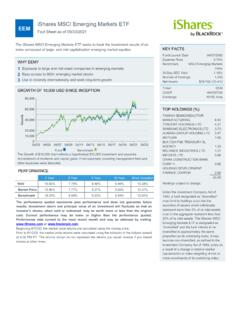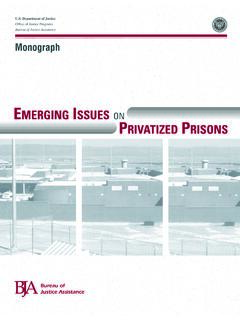Transcription of VACCINE MARKET PLACE - World Health Organization
1 1 | Global VACCINE MARKET Features and Trends Miloud Kaddar Senior Adviser, Health Economist WHO, IVB, Geneva 2 | GLOBAL VACCINE MARKET MAIN FEATURES OF THE VACCINE MARKET ? NEW TRENDS SINCE 2000 ? IMPLICATIONS ? 3 | VACCINE MARKET North South GAP Industrialised countries Developing countries Population BoD VACCINE sales 15% 85% 7% 93% 82% 18% 4 | VACCINE MARKET STRUCTURE 2010 World sales for drugs Vaccines US share Non- US Paediatric US Adult Small size MARKET : 2/3% of the global pharmaceutical MARKET but.
2 Spectacular growth rate : 10 - 15% per year versus 5-7 % for Pharmaceuticals 5 | VACCINE segments Human vaccines Pediatrics Adolescents Adults Elderly 6 | GLOBAL VACCINE MARKET : RAPID GROWTH and CHANGING STATUS Tripled in value from USD 5B in 2000 to almost USD 24 B in 2013 Influenza VACCINE MARKET : estimated at $ billion in 2011 to $ billion by 2018 US : $ billion in 2011 to $ billion in 2018 Global MARKET projected to rise to USD 100 B by 2025 More than 120 new products in the development pipeline 60 are of importance for developing countries Vaccines: becoming an engine for the pharmaceutical industry Changing status of the vaccines within the pharmaceutical industry New business model for vaccines is emerging ? 7 | Main features of VACCINE MARKET (2) Newer and more expensive vaccines are coming into the MARKET faster than ever before Growing concentration in OECD countries but also newcomers (Pfizer, J&J.)
3 VACCINE development: increasing investment 8 | MERGERS AND ACQUISITIONS 2002-2007: Illustration 9 | Overview of major VACCINE related acquisitions (2005-2012) Target Company Acquiring Company Investment Made Date Announced Bio of Netherlands Tianyuan Bio Serum Institute of India Ltd Novartis Pfizer Euros 80M $ 125 M? $68 bn July 2012 March 2011 Jan 2009 AstraZenecea $ bn April 2007 Novartis $ bn Oct 2005 Johnson & Johnson $ bn Sep 2009 7. ID Biomedical GSK $ bn Sep 2005 Bio Sanofi Aventis $781 mn July 2009 Sanofi Aventis $549 mn July 2008 10. Intercell Novartis $363 mn July 2007 11. Corixa GSK $300 mn May 2005 12. PowderMed Pfizer $230 mn Oct 2006 13. Coley Pfizer $214 mn Nov 2007 Source:VacZine Analytics + Fierce VACCINE 10 | 5 large multi-national corporations make up 80% of the global MARKET Major focus on new VACCINE development for industrialised country markets 11 | Brand name (producer) Type/composition 2010 sales (US$) Prevnar-13 (Pfizer) 13-valent pnenumococcal conjugate VACCINE $ billion Proquad (Merck/Sanofi-Aventis) Measles-mumps-rubella and varicella combination VACCINE (MMR-V) $ billion Gardasil (Merck) HPV $ billion Prevnar (Pfizer) 7-valent pnenumococcal conjugate VACCINE $ billion Fluzone (Sanofi Pasteur) Influenza (seasonal and H1N1 strains) $ billion Infanrix and Pediarix) (GSK) Infanrix = DTaP Pediarix = DTap-HepB-IPV (combination DPT-based vaccines with acellular pertussis) $ billion Source.
4 Krishan Maggon knoll ( ) Top product sales in 2010 12 | VACCINE Company H1 Sales Use 1 Prevnar 13 Pfizer $ billion Pneumococcal infection 2 PENTAct-HIB Sanofi $672 million Diphtheria, Pertussis/whooping cough; Tetanus; Polio; Haemophilus influenza type b 3 Gardasil Merck & Co $608 million human papillomavirus (HPV) 4 Pediarix GlaxoSmithKline $535 million Diphtheria; Tetanus; Pertussis/whooping cough; Hepatitis B; Polio 5 Hepatitis VACCINE Franchise GlaxoSmithKline $500 million Hepatitis A; Hepatitis B 6 Celtura Novartis $441 million Swine flu 7 Varivax Merck & Co. $392 million Varicella virus 8 Cervarix GlaxoSmithKline $285 million HPV 9 RotaTeq Merck & Co. $284 million Rotaviral gastroenteritis 10 Synflorix GlaxoSmithKline $274 million Pneumococcal infection; Otitis media 11 Rotarix GlaxoSmithKline $266 million Rotaviral gastroenteritis Total sales First half 2012 13 | Total sales First half 2012 (2) VACCINE Company H1 Sales Use 12 Zostavax Merck & Co.
5 $224 million Shingles; Herpes 13 Prevnar 7 Pfizer $222 million Pneumococcal infection; Otitis media 14 Fluzone/Vaxigrip Sanofi $219 million Influenza 15 Menactra Sanofi $217 million Meningitis 16 Pneumovax Merck & Co. $213 million Pneumococcal infection 17 Adacel Sanofi $207 million Diphtheria; Pertussis/whooping cough; Tetanus 18 MMR-II Merck & Co. $180 million Measles, Mumps, Rubella 19 Boostrix GlaxoSmithKline $165 million Diphtheria; Tetanus; Pertussis/whooping cough 20 Biothrax Emergent BioSolutions $88 million Anthrax Sources: EvaluatePharma; Fiercevaccines, Sep 2012 14 | VACCINE MARKET : GROWTH FACTORS ? Combination of : - Importance of communicable diseases and new threats - Cost effectiveness of immunizations - New funding opportunities (Gov, PPP, donors, Foundations,..) - New research techniques and manufacturing technologies - Increasing demand, new target population, larger emerging markets - Higher prices, improved profitability for the industry (blockbuster ) EPI SEMINAR APRIL 2008 15 | Developing countries: VACCINE MARKET share and trends 16 | Developing country MARKET 80 % of population / less than 20% of global MARKET Regular and rapid growth in volume and dollar value emerging economies and markets UN MARKET Private sector in Low and Middle income countries 17 | MNC : Key strategies for developing countries emerging economies UN markets (UNICEF/GAVI and PAHO) Private sector, middle income group markets 3 main targets: 18 | Arrangements with emerging economies and manufacturers Various types of arrangments, contracts and partnerships Taking into account country potentials and particularities.
6 Size of population and potential MARKET , legislation favouring or not domestic production and TT, production costs, scientific and technical capacity, price regulation, NIP, immunization in the private sector, regional influence,.. Directly with countries and local manufacturers or through PPP or PDP 19 | Various types of arrangements Cr ation of local branches Labelling, filling, bulk,.. Acquisition and absorption of local firms Outsourcing marketing and distribution Objectives: lower costs, increase production capacity, competitive position access to large public and private MARKET , .. 20 | A new trend: more active VACCINE marketing in DC emerging markets such as Mexico, Brazil, Turkey, Indonesia, Russia, China and India are among key priorities for MNC Singapour, Malaysia, Vietnam, Philippines, Egypt, GCC and others: second line Wide licensing and registration of new and innovative vaccines Increased presence of sale forces and MNC representatives : "pharma like model" 21 | New business MNC model is emerging ?
7 More mapping, MARKET segmentation and price differentiation Outsourcing selected part of R&D, production and commercialization/Access to promising markets and local capacities, low costs Risk sharing with countries and funders Collaborative networks and active presence at GHIs 22 | UN MARKET : UNICEF and PAHO Spectacular increase in the last 10 years Both UNICEF SD and PAHO Polio, measles, new vaccines National, regional and global priority MDGs, GIVS, GAVI, AMC, IFFim, GPEI, Measles partnership, BMGF, DOV/GVAP 23 | UN MARKET (in value) 2002 2011 % UNICEF SD $ 220 million $ 1,03 Billion + 468% PAHO RF $ 120 million $ 400 million + 333% Total $ 340 million $1,430 billion + 420% Around 7, 5 % of total VACCINE sales Sources: our WHO estimates based on UNICEF SD and PAHO RF data 24 | $0$100$200$300$400$500$600$700$800$90019 7819791980198119821983198419851986198719 8819891990199119921993199419951996199719 9819992000200120022003200420052006200720 0820092010 UNICEF SD Annual procurement value of vaccines, in million USD UNICEF annual VACCINE procurement has increased five fold since 2000 - supporting UNICEF Programmes and on behalf of Partners, Global Programmes, Governments and NGO s The arrows indicate the main programme drivers for the increased procurement value.
8 Source UNICEF Supply Division 25 | The UNICEF 2012: buying 50% of the global volume of VACCINE doses, mainly EPI vaccines, but representing only 5% of total MARKET value 50% 5% Global Volume of Doses Global Value of Doses Sources. UNICEF SD 26 | emerging MANUFACTURERS ARE PLAYING AN ACTIVE ROLE Brazil Indonesia China India Cuba S. Korea Panacea Biotec Shantha Biotechnics Bharat Biotech Biological E (BE) Serum Inst. of India CIGB Instituto Finlay Berna Green Cross (Berna) LG Life Sciences (LG) Bio-Manguinhos Butantan Institute Biofarma Chengdu Shanghai (SIBP) Sinovac Shenzhen AVP Shenzhen Kangtai Mexico Birmex Year Total # Pre-Qualified Vaccines (excluding pandemic influenza) # Pre-Qualified Vaccines by emerging Manufacturers (excluding pandemic influenza) % of Pre-Qualified Vaccines by emerging Manufacturers # emerging Manufacturer Countries with Functional NRA's 2003 66 21 6 2006 73 31 6 2009 98 47 6 2010 102 50 7 Source: WHO-IVB-QSS.
9 As of September 6, 2010 Number of Pre-Qualified Vaccines by Year with Shares from emerging Manufacturers020406080100120200320062009 2010 YearNumber of Pre-Qualified Vaccines(exluding pandemic influenza)Total # Pre-Qualified Vaccines# Pre-Qualified Vaccines byEmerging Manufacturers28 | UNICEF SD emerging vs. Industrialized manufacturers By Volume By Value 28 *2010 2012 Data based on awards already made by UNICEF emerging MARKET Country Manufacturers make up approximately 50% of procurement volumes in 2010 and 30% by value, predominantly due to lower but increasing participation in new VACCINE markets and differing cost bases 29 | Growth of the PAHO Revolving Fund 91 92 93 94 95 96 97 98 99 00 01 02 03 04 05 06 07 08 09 10 11 12 Years 0 100 200 300 400 500 600 $US (millions) Expenditure Capitalization Rotavirus Introduced Influenza Introduced Penta, YF Introduced MMR Introduced Additional Countries Introduction Source : WHO PAHO 30 | The PAHO Revolving Fund Update: 2012 60 products 28 antigens 39 countries & territories Expected Purchases:US$ 405 million Capital Fund.
10 US$ 100 million PAHO 31 | Top ten suppliers of PAHO RF 2003-2008 In 2008, no one manufacturer accounted for more than 23% of PAHO purchases EPI SEMINAR APRIL 2008 32 | NEW TRENDS ? EPI SEMINAR APRIL 2008 33 | New trends ? Vaccines and vaccinations : on the top of GoV and UN agenda, unmet needs Accelerate uptake and increasing demand in LIC Middle Income countries including emerging Countries Demand side Increasing capacity Remaining tensions on products New production and supply strategies Supply GoV resources Donors Private foundations Funding More players on demand, supply and financing EPI SEMINAR APRIL 2008 34 | By 2025, there will only be 20 LICs Number of countries by income classification and year RED = MIC; BLUE = LIC Source: Leo and Moss, 2011 CGD A. Glassman Development of "MIC VACCINE MARKET products" MIC EPI SEMINAR APRIL 2008 35 | New trends in the last 5 years and their implications 1)Supply side Newcomers: Pfizer, Novartis, Johnson and Johnson.

















